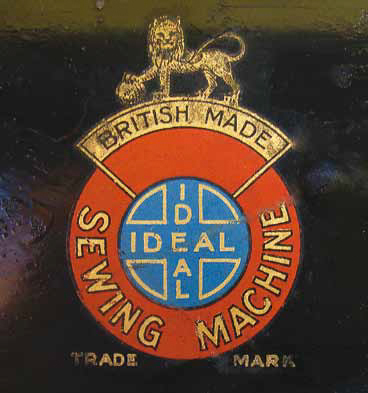Leslie Salter's Ideal Sewing Machine

Fig. 9: the 'Ideal' with its sheet steel cover

Fig. 6: the first version of the 'Ideal'
Leslie Salter of Coptall Avenue, London, designed a simple chainstitch sewing machine in 1910 using an oscillating hook mechanism.
He invested one pound (£1) in a provisional patent for it on 30th December 1910 and spent the next six months trying to make it work and paying for a full patent which was granted on 8th June 1911 (No. 30,264).
A look at the drawings in the full patent (Figure 1) shows a crude oscillating hook 'waggled' by a lever from a cam on the upper shaft.
The tolerances or 'play' in the mechanism make it an even more problematic sewing machine than the 1861 Raymond patent for his oscillating hook mechanism.
However, Salter persevered at trying to get his machine into production although the First Wold War (1914-18) intervened. An alternative shuttle version was provisionally patented by a Herbert Westcott in 1914, and in 1916, in the USA (No 1200675), but never saw the light of day.
After the end of the War in 1918 Salter renewed his interest and in 1921 The Ideal Sewing Machine Company Limited was launched with a share capital of £100 000 in two million shares with a nominal value of one shilling each.

Fig. 1: the Patent drawings for Salter's patent No. 30264 of 8th June 1911.

Fig. 5: cover of the instruction leaflet

Fig. 7: the 'walking foot' mechanism

Fig. 5: page 2 of the instruction leaflet

Fig. 11: the stamp on the clothplate.
Figure 2 shows a share certificate issued to Mr. Griffiths of Newport, Monmouth, for his investment of £25 for 500 shares in May 1922. The company had an office at 66 Broad Street, London EC2. Fig. 3 shows a 1921 advertisement for the machine which has a very 1920s Art Deco feel to it.
The machine on sale was a small chainstitch machine nickel plated all over and mounted on a simple oak base. A japanned sheet steel cover was supplied which clipped to the base. It was sold by such upmarket stores as Selfridges and Harrods. The machine featured a 'walking foot' top feed like the early Raymond machines of sixty years earlier. The original machine had the needle drive and feed mechanism exposed but later a sheet steel cover stamped 'Ideal' was added. The instruction leaflet (Figures 4 & 5) has only four pages and is printed on very poor quality paper. Figs. 6 to 11 show the machine as sold.

Fig. 3: a pretty pompous claim for a machine in 1921!
The company did not survive long, probably failing towards the end of 1922. Presumably Mr Griffiths lost his £25! We do not know where the machines were made or who made them. It is surprising that funds could be raised in 1921 to launch a new machine for a market which had died by 1880. Quite a few must have been produced to judge from the number of survivors which turn up on Ebay, etc. The nickel plating was of poor quality and soon flakes off when the machines have been stored in damp conditions.
As an afterthought, a series of real photo postcards were published during the Second World War (1939-45) by the Rotary Photographic Co. of London showing a young girl using an 'Ideal' sewing machine (Fig. 12). The back of the card has a pre-printed greeting and the legend: "We have to gain the Victory. That is our task." The Prime Minister.

Fig. 8: the hand wheel and folding handle

Fig. 2: share certificate for The Ideal Sewing Machine Co. Ltd. issued to George William Albert Griffiths on 1st May 1922 for 500 shares

Fig. 12: the needle bar cover, stamped 'Ideal'

Fig. 10: the trade mark on the cover






